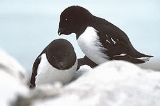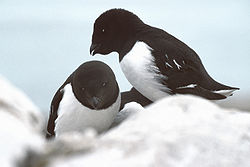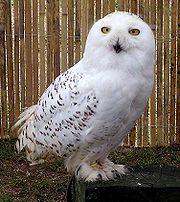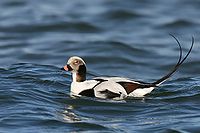
List of species on Severnaya Zemlya
Encyclopedia
Vascular plants
Most common:- CerastiumCerastiumCerastium is a genus of annual, winter annual, or perennial plants belonging to the family Caryophyllaceae. The around 100 species are commonly called Mouse-ear chickweed; different species are found nearly worldwide but the greatest concentration is mainly from the northern temperate areas of the...
sp. - Papaver polare
- Saxifraga caespitosa
- Saxifraga oppositifolia
Less common:
- Alopecurus alpinus
- Cerastium regelii
- DeschampsiaDeschampsiaDeschampsia is a genus of grasses in the family Poaceae, commonly known as hair grass or tussock grass. There are 30 to 40 species....
sp. - DrabaDrabaDraba is a large genus of cruciferous plants, commonly known as whitlow-grasses. There are over 400 species:*Draba abajoensis Windham & Al-Shehbaz*Draba × abiskoensis O.E.Schulz*Draba × abiskojokkensis O.E.Schulz...
sp. - Eritrichum villosum
- Novosieversia glacialis
- PhippsiaPhippsiaPhippsia is a genus of grass in the Poaceae family.- External links :*...
sp. - Poa abbreviata
- Poa arctica
- Saxifraga cernua
- Saxifraga nivalisSaxifraga nivalisSaxifraga nivalis is a species of saxifrage. It is commonly called Snow Saxifrage or "alpine saxifrage".Found on irrigated rocks or open vegetation in shaded sites, often on mountain ledges and crags with base rich substratum. This species is not very tolerant of competition and so is found in...
- Salk polare
- StellariaStellariaStellaria is a genus of about 90-120 species flowering plants in the family Caryophyllaceae, with a cosmopolitan distribution. Common names include stitchwort and chickweed.-Food use:...
sp. - MinuartiaMinuartiaMinuartia is a genus of small flowering plants, one of those commonly known as "sandwort" or "stitchwort". The genus is classed within the family Caryophyllaceae, the pink family, characterised by its opposite and decussate leaves....
sp.
Mosses
Most common:- Detrichum flexicaule
- DicranumDicranumDicranum is a genus of mosses, also called Wind-Blown Mosses or Fork Mosses.These mosses form in densely packed clumps. Stems may fork, but do not branch. In general, upright stems will be single but packed together. These are commonly found in Jack pine or Red pine stands....
sp. - Pogonatum sp.
- Sanionia sp.
- Bryum sp.
- Orthothecium chryseum
- Tortura sp.
Less common:
- AndreaeaAndreaeaAndreaea is a genus of rock mosses with about 45 species.- External links :* Zander, Richard H. 2007. Bryophyte Flora of North America:...
sp. - Aulacomnium turgidum
- Bryum cryophilum
- Calliergon giganteum
- Calliergon obtusifolium
- Calliergon sarmentosum
- Calliergon giganteum
- Campylophus sp.
- Dichodontium sp.
- Dicranoweisia sp.
- Dicranoweisia crispulaDicranoweisia crispulaDicranoweisia crispula is a species of moss that lives at both poles. It grows in the South Shetland Islands and on the Antarctic Peninsula.-References:*...
- Dirrichum sp.
- Ditrichum flexicaule
- Drepanocladus revolvens
- Drepanocladus exannulatus
- Hylocomium splendensHylocomium splendensHylocomium splendens, commonly known as Glittering Wood-moss, Stair-step Moss and Mountain Fern Moss, is a perennial clonal moss with a widespread distribution in Northern Hemisphere boreal forests. It is commonly found in Europe, Russia, Alaska and Canada, where it is often the most abundant moss...
- Jungermannia sp.
- Loeskypnum badium
- Philonotis sp.
- PolytrichumPolytrichumPolytrichum is a genus of mosses — commonly called haircap moss or hair moss — which contains approximately 70 species that cover a cosmopolitan distribution....
sp. - Ptilidium ciliare
- Racomitrium lanuginosum
- Sanionia uncinata
- Schistidium apocarpum
- Scorpidium turgescens
- Tomenthypnum nitens
Lichens
Most common:- Cetraria nivalis
- Thamnolia vermicularis
- CetrariaCetrariaCetraria is a genus of fruticose lichens that associate with green algae as photobionts. Most species are found at high latitudes, occurring on sand or heath...
sp. - CorniculariaCorniculariaCornicularia is a genus of lichenised ascomycetes in the large family Parmeliaceae. It is a monotypic genus, with only one currently accepted species: Cornicularia normoerica. This species has an erect caespitose growth form, and is sometimes referred to as the brittle lichen.-External links:* at...
sp. - LecideaLecideaLecidea is a lichenized genus of fungi within the Lecideaceae family. According to the Dictionary of the Fungi , the widespread genus contains an estimated 427 species....
sp. - OchrolechiaOchrolechiaOchrolechia is a genus of lichen belonging to the suborder Lecanorineae.-External links:*...
sp. - ParmeliaParmelia (lichen)Parmelia is a large genus of lichenized fungus with a global distribution, extending from the Arctic to the Antarctic continent but concentrated in temperate regions. 125 species have been recorded on the Indian sub-continent...
sp.
Less common:
- Alectoria sp.
- BuelliaBuelliaBuellia is a genus of lichenized fungi in the family Caliciaceae. The genus has a widespread distribution and contains about 450 species....
sp. - CaloplacaCaloplacaCaloplaca is a lichen genus, composed of a number of distinct species. The distribution of this lichen genus is world wide, extending from Antarctica to the high Arctic. It includes a portion of northern North America and the Russian High Arctic. There are about thirty species of Caloplaca in the...
sp. - Cetaria cucullata
- Cetaria sp.
- CladiaCladiaCladia is a genus of lichenized fungi in the family Cladoniaceae.-External links:*...
sp. - CladoniaCladoniaCladonia is a genus of moss-like lichens in the family Cladoniaceae. They are the primary food source for reindeer and caribou. Cladonia species are of economic importance to reindeer-herders, such as the Sami in Scandinavia or the Nenets in Russia. Antibiotic compounds are extracted from some...
sp. - Dactylina arcticaDactylina arcticaDactylina arctica is a species of fungus within the family Parmeliaceae. Common names for this lichen are Finger Lichen and Arctic Finger Lichen. A specific area in which this lichen occurs is represented by the Boreal forests of Canada....
- DermatocarponDermatocarponDermatocarpon is a genus of fungi in the family Verrucariaceae.-External links:*...
sp. - HypogymniaHypogymniaHypogymnia is a genus of lichenized fungi within the Parmeliaceae family....
sp. - Ochrolechia frigida
- PeltigeraPeltigeraPeltigera is a genus of approximately 91 species of lichenized fungi in the family Peltigeraceae.Commonly known as the dog lichen, lichens of Peltigera are often terricolous , but can also occur on moss, trees, rocks, and many other substrates in many parts of the world...
sp. - RamalinaRamalinaRamalina is a genus of lichens belonging to the suborder Lecanorineae. The genus has a widespread distribution and contains over 240 species....
sp. - RhizocarponRhizocarponRhizocarpon is a lichenized genus of fungi within the Rhizocarpaceae family.-External links:* at Index Fungorum...
sp. - SphaerophorusSphaerophorusSphaerophorus a genus of lichenized fungi in the order Lecanorales. According to the Dictionary of the Fungi , the widespread genus contains eight species....
sp. - Stereocaulon sp.
- Thamnolia vermicularis
- ThamnoliaThamnoliaThamnolia is a genus of lichenized fungi in the family Icmadophilaceae.-Species:* Thamnolia vermicularis is a species found in may parts of the world, including high parts of Namadgi National Park in the Australian Capital Territory and Severnaya Zemlya...
sp. - Umbilicaria sp.
- Xanthoria elegansXanthoria elegansXanthoria elegans, commonly known as the elegant sunburst lichen, is a lichenized species of fungus in the genus Xanthoria, family Teloschistaceae. Recognized by its bright orange or red pigmentation, this species grows on rocks, often near bird or rodent perches. It has a circumpolar and alpine...
- XanthoriaXanthoriaXanthoria is a genus of lichenized fungi in the family Teloschistaceae.-External links:*...
sp.
Fauna

Breeding birds
- little aukLittle AukThe Little Auk, or Dovekie , is a small auk, the only member of the genus Alle. It breeds on islands in the high Arctic. There are two subspecies: A. a. alle breeds in Greenland, Iceland, Novaya Zemlya and Spitsbergen, and A. a...
(Alle alle) - kittiwakeKittiwakeThe kittiwakes are two closely related seabird species in the gull family Laridae, the Black-legged Kittiwake and the Red-legged Kittiwake . The epithets "Black-legged" and "Red-legged" are used to distinguish the two species in North America, but in Europe, where R...
(Rissa tridactyla) - black guillemotBlack GuillemotThe Black Guillemot or Tystie is a medium-sized alcid.Adult birds have black bodies with a white wing patch, a thin dark bill, and red legs and feet. They show white wing linings in flight. In winter, the upperparts are pale grey and the underparts are white. The wings remain black with the large...
(Cepphus grylle) - ivory gullIvory GullThe Ivory Gull Pagophila eburnea is a small gull, the only species in its genus. It breeds in the high arctic and has a circumpolar distribution through Greenland, northernmost North America, and Eurasia.-Taxonomy:...
(Pagophila eburnea) - glaucous gullGlaucous GullThe Glaucous Gull is a large gull which breeds in the Arctic regions of the northern hemisphere and the Atlantic coasts of Europe. It is migratory, wintering from in the North Atlantic and North Pacific oceans as far south as the British Isles and northernmost states of the USA, also on the Great...
(Larus hyperboreus) - snow buntingSnow BuntingThe Snow Bunting , sometimes colloquially called a snowflake, is a passerine bird in the longspur family Calcariidae. It is an arctic specialist, with a circumpolar Arctic breeding range throughout the northern hemisphere...
(Plectrophenax nivalis) - purple sandpiperPurple SandpiperThe Purple Sandpiper, Calidris, Arquatella or Erolia maritima is a small shorebird.Adults have short yellow legs and a medium thin dark bill with a yellow base. The body is dark on top with a slight purplish gloss and mainly white underneath. The breast is smeared with grey and the rump is black...
(Calidris maritima) - brent gooseBrent GooseThe Brant or Brent Goose, Branta bernicla, is a species of goose of the genus Branta. The Black Brant is an American subspecies. The specific descriptor bernicla is from the same source as "barnacle" in Barnacle Goose, which looks similar but is not a close relation.-Appearance:The Brant Goose is...
(Branta bernicla).
- Arctic ternArctic TernThe Arctic Tern is a seabird of the tern family Sternidae. This bird has a circumpolar breeding distribution covering the Arctic and sub-Arctic regions of Europe, Asia, and North America...
(Sterna paradisaea) - herring gull (Larus argentatus)
- red-throated diverRed-throated DiverThe Red-throated Loon or Red-throated Diver is a migratory aquatic bird found in the northern hemisphere. It breeds primarily in Arctic regions, and winters in northern coastal waters. It is the most widely distributed member of the loon or diver family. Ranging from in length, the Red-throated...
(Gavia stellata) - king eiderKing EiderThe King Eider is a large sea duck that breeds along northern hemisphere Arctic coasts of northeast Europe, North America and Asia. The birds spend most of the year in coastal marine ecosystems at high latitudes, and migrate to Arctic tundra to breed in June and July...
(Somateria spectabilis) - sanderlingSanderlingThe Sanderling is a small wader. It is a circumpolar Arctic breeder, and is a long-distance migrant, wintering south to South America, South Europe, Africa, and Australia...
(Calidris alba) - Arctic skuaArctic SkuaThe Parasitic Jaeger, also known as the Arctic Skua or Parasitic Skua, is a seabird in the skua family Stercorariidae....
(Stercorarius parasiticus) - long-tailed skuaLong-tailed SkuaThe Long-tailed Skua, Stercorarius longicaudus is a seabird in the skua family Stercorariidae....
(Stercorarius longicaudus) - snowy owlSnowy OwlThe Snowy Owl is a large owl of the typical owl family Strigidae. The Snowy Owl was first classified in 1758 by Carolus Linnaeus, the Swedish naturalist who developed binomial nomenclature to classify and organize plants and animals. The bird is also known in North America as the Arctic Owl, Great...
(Bubo scandiacus)

- Lapland buntingLapland BuntingThe Lapland Longspur or Lapland Bunting, Calcarius lapponicus, is a passerine bird in the longspur family Calcariidae, a group separated by most modern authors from the Fringillidae ....
(Calcarius lapponicus).
- pomarine skuaPomarine SkuaThe Pomarine Skua, Stercorarius pomarinus, known as Pomarine Jaeger in North America, is a seabird in the skua family Stercorariidae. It is a migrant, wintering at sea in the tropical oceans.- Taxonomy :...
(Stercorarius pomarinus) - Ross's gullRoss's GullThe Ross's Gull is a small gull, the only species in its genus, although it has been suggested it should be moved to the genus Hydrocoloeus, which otherwise only includes the Little Gull....
(Rhodostethia rosea)
Transient birds
- Brünnich's GuillemotBrünnich's GuillemotThe Thick-billed Murre or Brünnich's Guillemot is a bird in the auk family . This bird is named after the Danish zoologist Morten Thrane Brünnich...
(Uria lomvia) - RookRook (bird)The Rook is a member of the Corvidae family in the passerine order of birds. Named by Carl Linnaeus in 1758, the species name frugilegus is Latin for "food-gathering"....
(Corvus frugilegus) - White WagtailWhite Wagtail"Pied Wagtail" redirects here. For the related African bird, see African Pied Wagtail.The White Wagtail is a small passerine bird in the wagtail family Motacillidae, which also includes the pipits and longclaws. This species breeds in much of Europe and Asia and parts of north Africa...
(Motacilla alba) - FulmarFulmarFulmars are seabirds of the family Procellariidae. The family consists of two extant species and two that are extinct.-Taxonomy:As members of Procellaridae and then the order Procellariiformes, they share certain traits. First, they have nasal passages that attach to the upper bill called...
(Fulmarus glacialis) - Long-tailed DuckLong-tailed DuckThe Long-tailed Duck or Oldsquaw is a medium-sized sea duck. It is the only living member of its genus, Clangula; this was formerly used for the goldeneyes, with the Long-tailed Duck being placed in Harelda...
(Clangula hyemalis) - Common EiderCommon EiderThe Common Eider, Somateria mollissima, is a large sea-duck that is distributed over the northern coasts of Europe, North America and eastern Siberia. It breeds in Arctic and some northern temperate regions, but winters somewhat farther south in temperate zones, when it can form large flocks on...
(Somateria mollissima) - Peregrine FalconPeregrine FalconThe Peregrine Falcon , also known as the Peregrine, and historically as the Duck Hawk in North America, is a widespread bird of prey in the family Falconidae. A large, crow-sized falcon, it has a blue-gray back, barred white underparts, and a black head and "moustache"...
(Falco peregrinus) - Rock Ptarmigan (Lagopus mutus)
- KnotRed KnotThe Red Knot, Calidris canutus , is a medium sized shorebird which breeds in tundra and the Arctic Cordillera in the far north of Canada, Europe, and Russia. It is a large member of the Calidris sandpipers, second only to the Great Knot...
(Calidris canutus) - Sharp-tailed SandpiperSharp-tailed SandpiperThe Sharp-tailed Sandpiper, Calidris acuminata is a small wader.- Taxonomy :More recently, a review of new data has indicated that this bird should perhaps better be placed into the genus Philomachus- as P...
(Calidris acuminata) - Red PhalaropeRed PhalaropeThe Red Phalarope , Phalaropus fulicarius, is a small wader. This phalarope breeds in the Arctic regions of North America and Eurasia...
(Phalaropus fulicarius) - Great SkuaGreat SkuaThe Great Skua, Stercorarius skua, is a large seabird in the skua family Stercorariidae. In Britain, it is sometimes known by the name Bonxie, a Shetland name of unknown origin.-Description:...
(Catharacta skua) - Sabine's GullSabine's GullThe Sabine's Gull is a small gull. Its generic placement is disputed; some authors treat it as the sole species in the genus Xema as Xema sabini, while others retain it in the genus Larus as Larus sabini. It breeds in the arctic and has a circumpolar distribution through northernmost North America...
(Xema sabini)

Mammals
- collared lemmingCollared lemmingDicrostonyx is a genus of rodent in the family Cricetidae. It contains the collared lemmings.It contains the following species:* Northern Collared Lemming * Ungava Collared Lemming...
(Dicrostonyx torquatus)
- Arctic foxArctic foxThe arctic fox , also known as the white fox, polar fox or snow fox, is a small fox native to Arctic regions of the Northern Hemisphere and is common throughout the Arctic tundra biome. The Greek word alopex, means a fox and Vulpes is the Latin version...
(Alopex lagopus) - wolf (Canis lupus)
- ermineErmineErmine has several uses:* A common name for the stoat * The white fur and black tail end of this animal, which is historically worn by and associated with royalty and high officials...
(Mustela erminea) - Arctic hareArctic HareThe arctic hare , or polar rabbit is a species of hare which is adapted largely to polar and mountainous habitats. The arctic hare survives with a thick coat of fur and usually digs holes under the ground or snow to keep warm and sleep...
(Lepus timidus) - reindeerReindeerThe reindeer , also known as the caribou in North America, is a deer from the Arctic and Subarctic, including both resident and migratory populations. While overall widespread and numerous, some of its subspecies are rare and one has already gone extinct.Reindeer vary considerably in color and size...
(Rangifer tarandus).

